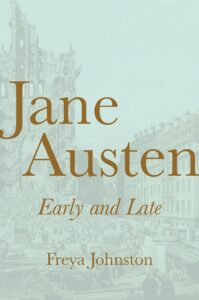In Jane Austen, Early and Late, an Oxford University lecturer, Freya Johnston argues Austen’s early and late work are inextricably bound together and should be equally read and cherished. The structure of the book provides six lenses through which Johnston connects Austen’s early and late works. While “Histories” discusses the sense of timeline in Austen’s novels and the difference between a character’s perception of time versus the narrator’s knowledge of “real-time”, “Dying with Laughter” considers Austen’s work in the context of her personal life. Perhaps the best section of the book is “Developing” which considers Austen’s authorial development and whether to order her books by its date of publication or creation length. Readers and critics alike often categorize “later” works as better in comparison to “early” ones.
As most Charlotte Brontë fans, myself included, would likely agree, Jane Eyre (1847) is her masterpiece, not the dreary Villette (1853) with its unreliable and unlikeable narrator. Johnston proves the same can be said for Austen: distinguishing between early and late is fruitless in determining which of her works are “better”. Johnston uses a chronology of Austen’s longer novels — compiled by Jane’s sister, Cassandra — to suggest the time spent on two distinct novels cannot be separated into different periods of her life.
It is well known to Austen’s fans that Pride and Prejudice began as an epistolary novel titled First Impressions; she began the latter in 1796, published the former in 1813, and in the intervening years wrote Sense and Sensibility (1811) and Mansfield Park (1814). The origins of her full-length stories can be traced back to her juvenilia. For example, the heroine of Northanger Abbey, Catherine Morland, can be traced back to young Austen’s Kitty Peterson in “Kitty, or the Bower.” Johnston makes similar connections between other pieces of Austen’s “early” work and across other aspects of her published novels.



